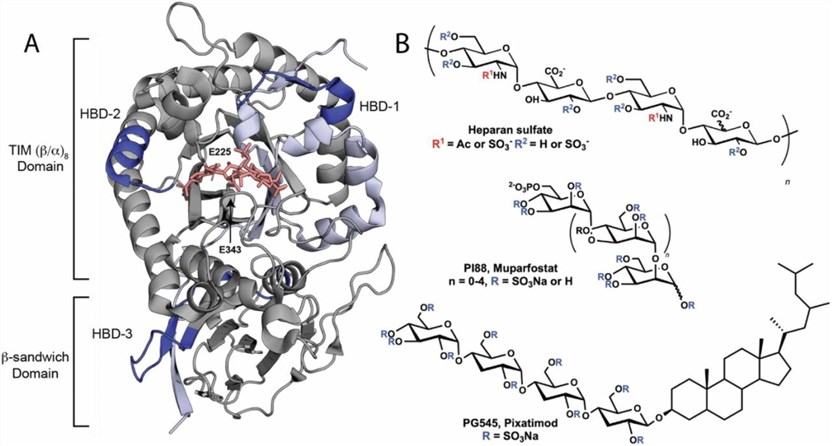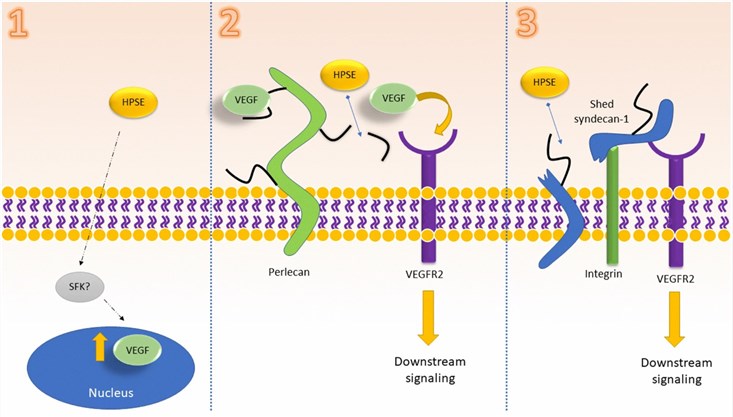What is HPSE Protein
What is HPSE Protein?
Heparanase (HPSE) protein, encoded by the HPSE gene, exerts profound effects on cellular processes. Structurally, HPSE is an endo-β-D-glucuronidase, specializing in the modification of heparan sulfate proteoglycans (HSPGs). These proteoglycans are components of the extracellular matrix (ECM) and cell surface.

Figure 1. Crystal structure of HPSE and known inhibitors. (Whitefield, C., et al. 2023)
The Function of HPSE Protein
- Remodeling the ECM
One of the primary functions of HPSE is the modification of the ECM through cleavage of heparan sulfate chains. This remodeling process has a cascading effect on cell-matrix interactions, influencing cell adhesion, migration, and invasion. By altering the ECM, HPSE actively participates in tissue development, wound healing, and pathological processes such as cancer metastasis.
- Angiogenesis Regulation
HPSE has been implicated in the regulation of angiogenesis, the formation of new blood vessels. Through its enzymatic activity, HPSE contributes to the release of pro-angiogenic factors, facilitating the sprouting of blood vessels. This function is critical in various physiological processes like embryonic development and tissue repair but can also be hijacked in diseases like cancer, where aberrant angiogenesis is a hallmark.
HPSE-Related Diseases
- Cancer Metastasis
Perhaps one of the most extensively studied aspects of HPSE biology is its involvement in cancer metastasis. Elevated levels of HPSE are often observed in various cancer types and are correlated with increased invasiveness and metastatic potential. The enzymatic activity of HPSE promotes the degradation of the ECM, facilitating the escape of cancer cells from the primary tumor site and their dissemination to distant organs.
- Inflammatory Disorders
HPSE's influence extends to the realm of inflammation, where dysregulated expression becomes a harbinger of disorders like inflammatory bowel disease (IBD) and rheumatoid arthritis. The breakdown of ECM by HPSE contributes to the release of inflammatory mediators, setting the stage for chronic inflammation and tissue damage. Unraveling the intricate dance between HPSE and inflammation holds promise for novel therapeutic strategies.
- Neurological Disorders
In the ever-evolving landscape of neurological disorders, HPSE emerges as a player worth investigating. Altered HPSE expression raises eyebrows in conditions like Alzheimer's disease and multiple sclerosis. Though the specifics of HPSE's involvement in neurological disorders remain elusive, its modulation of neuroinflammation and neuronal interactions hints at a potential avenue for targeted interventions.
HPSE Related Signaling Pathways
The intricate signaling pathways associated with HPSE function are central to understanding its role in health and disease. One such pathway involves the activation of growth factors and cytokines following HPSE-mediated ECM remodeling. The release of sequestered growth factors, such as fibroblast growth factors (FGFs) and vascular endothelial growth factor (VEGF), can initiate downstream signaling cascades that promote cell proliferation, migration, and angiogenesis.
Moreover, HPSE has been linked to the activation of various intracellular signaling pathways, including the mitogen-activated protein kinase (MAPK) pathway and the phosphoinositide 3-kinase (PI3K)/Akt pathway. These pathways play pivotal roles in cellular processes such as survival, proliferation, and differentiation. Dysregulation of HPSE-mediated signaling can contribute to the pathogenesis of diseases, especially cancer, where uncontrolled cell growth and survival are hallmarks.

Figure 2. Proposed mechanism by which HPSE activates VEGFR signaling. (Koganti, R., et al. 2020)
Applications of HPSE in Biomedical Research
- Cancer Therapeutics
The tantalizing prospect of curbing cancer metastasis drives researchers to explore HPSE as a therapeutic target. Small molecule inhibitors and monoclonal antibodies, meticulously designed to thwart HPSE activity, emerge as potential game-changers.
- Angiogenesis Modulation
In conditions where abnormal angiogenesis fuels pathology, manipulating HPSE activity emerges as a strategic option. Diseases like age-related macular degeneration and certain cancers, characterized by excessive blood vessel formation, may find relief through interventions targeting HPSE. Precision in modulating angiogenesis holds the key to managing these conditions.
- Inflammatory Disease Management
The battlefield against inflammatory disorders witnesses the emergence of HPSE as a potential ally. Modulating HPSE activity offers a nuanced approach to tempering the inflammatory response and mitigating tissue damage. The prospect of developing drugs that selectively intervene in the HPSE cascade opens new doors for managing chronic inflammatory conditions.
- Neurological Disease Research
The enigmatic connection between HPSE and neurological disorders sparks a new frontier in research. As the dots connecting altered HPSE expression and conditions like Alzheimer's disease and multiple sclerosis are slowly connected, the prospect of targeted interventions in neuroinflammation and neuronal dysfunction gains momentum.
The HPSE protein stands as a multifaceted player in the cellular processes, influencing everything from ECM remodeling to angiogenesis and disease progression. As our understanding of HPSE deepens, so does the potential for innovative biomedical applications. From cancer therapeutics to the management of inflammatory disorders and neurological diseases, the versatile nature of HPSE opens doors to new possibilities in the realm of medical research.
Recommended Products for HPSE Protein
| Cat.# | Species | Product name | Source (Host) | Tag |
|---|---|---|---|---|
| HPSE-431H | Human | Active Recombinant Human HPSE protein, His-tagged | CHO | His |
| HPSE-213H | Human | Recombinant Human Heparanase | CHO | N/A |
| HPSE-5068H | Human | Recombinant Human HPSE, His-tagged | E.coli | His |
| HPSE-5019H | Human | Recombinant Human HPSE Protein, GST-tagged | Wheat Germ | GST |
| HPSE-3443H | Human | Recombinant Human HPSE Protein (Gln34-Arg115), N-His tagged | E.coli | N-His |
| HPSE-7838M | Mouse | Active Recombinant Mouse HPSE Protein, His-tagged | Myeloma cells | His |
| Hpse-704M | Mouse | Recombinant Mouse Hpse protein, His-tagged | E.coli | His |
| HPSE-2907R | Rat | Recombinant Rat HPSE Protein | Mammalian Cell | His |
| Hpse-707R | Rat | Recombinant Rat Hpse protein, His & T7-tagged | E.coli | His/T7 |
| HPSE-4085Z | Zebrafish | Recombinant Zebrafish HPSE | Mammalian Cell | His |
References
- Whitefield, C., et al. Complex Inhibitory Mechanism of Glycomimetics with Heparanase. Biochemistry. 2023, 62(14): 2202-2215.
- Koganti, R., et al. Heparanase, cell signaling, and viral infections. Cell. Mol. Life Sci. 2020, 77: 5059–5077.

